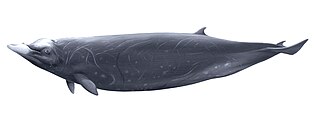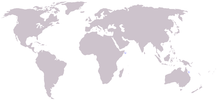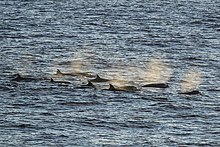Beaked whales are a family of cetaceans noted as being one of the least-known groups of mammals because of their deep-sea habitat, reclusive behavior and apparent low abundance. Only three or four of the 24 existing species are reasonably well-known. Baird's beaked whales and Cuvier's beaked whales were subject to commercial exploitation, off the coast of Japan, while the northern bottlenose whale was extensively hunted in the northern part of the North Atlantic in the late 19th and early 20th centuries.

Mesoplodont whales are 16 species of toothed whale in the genus Mesoplodon, making it the largest genus in the cetacean order. Two species were described as recently as 1991 and 2002, and marine biologists predict the discovery of more species in the future. A new species was described in 2021. They are the most poorly known group of large mammals. The generic name "mesoplodon" comes from the Greek meso- (middle) - hopla (arms) - odon (teeth), and may be translated as 'armed with a tooth in the centre of the jaw'.

Hubbs' beaked whale was initially thought to be an Andrews' beaked whale when discovered by ichthyologist Carl Hubbs; however, it was named in his honor when it was discovered to be a new species. This species has the typical dentition found in the genus, but its main outstanding features are a white "cap" on the head and very extensive scarring. The species is known from 31 strandings, a few at-sea sightings, and observations of two stranded whales that were kept in captivity for 16–25 days.

Blainville's beaked whale, or the dense-beaked whale, is believed to be the widest ranging mesoplodont whale. The French zoologist Henri de Blainville first described the species in 1817 from a small piece of jaw — the heaviest bone he had ever come across — which resulted in the name densirostris. Off the northeastern Bahamas, the animals are particularly well documented, and a photo identification project started sometime after 2002.

Gervais's beaked whale, sometimes known as the Antillean beaked whale, Gulf Stream beaked whale, or European beaked whale is the most frequently stranding type of mesoplodont whale off the coast of North America. It has also stranded off South America and Africa.

The ginkgo-toothed beaked whale is a poorly known species of whale even for a beaked whale, and was named for the unusual shape of its dual teeth. It is a fairly typical-looking species, but is notable for the males not having any scarring.

Gray's beaked whale, sometimes known as Haast's beaked whale, the scamperdown whale, or the southern beaked whale, is one of the better-known members of the genus Mesoplodon. This species is fairly gregarious and strands relatively frequently for a beaked whale. In the Māori language, this species is called hakurā or iheihe.

Hector's beaked whale, is a small mesoplodont living in the Southern Hemisphere. This whale is named after Sir James Hector, a founder of the colonial museum in Wellington, New Zealand. The species has rarely been seen in the wild.

The strap-toothed beaked whale, also known as Layard's beaked whale, is one of the largest members of the mesoplodont genus, growing to 6.2 m (20 ft) in length and reaching up to 1,300 kg (2,900 lb). The common and scientific name was given in honor of Edgar Leopold Layard, the curator of the South African Museum, who prepared drawings of a skull and sent them to the British taxonomist John Edward Gray, who described the species in 1865.

True's beaked whale is a medium-sized whale in the genus Mesoplodon. It is native to the northern Atlantic Ocean. The common name is in reference to Frederick W. True, a curator at the United States National Museum.

The pygmy beaked whale, also known as the bandolero beaked whale, Peruvian beaked whale and lesser beaked whale, is the smallest of the mesoplodonts and one of the newest discoveries. There were at least two dozen sightings of an unknown beaked whale named Mesoplodon sp. A before the initial classification, and those are now believed to be synonymous with the species. The species was formally described in 1991, based on ten specimens obtained from Peru between 1976 and 1989, including a 3.72 m (12.2 ft) adult male as the type specimen. A specimen that stranded at Paracas, Peru in 1955 has since been identified as a pygmy beaked whale. Since 1987, there have been an additional 40 sightings of the species, for a total of 65.

The four-toothed whales or giant beaked whales are beaked whales in the genus Berardius. They include Arnoux's beaked whale in cold Southern Hemispheric waters, and Baird's beaked whale in the cold temperate waters of the North Pacific. A third species, Sato's beaked whale, was distinguished from B. bairdii in the 2010s.

Arnoux's beaked whale, also called the southern four-toothed whale, southern beaked whale, New Zealand beaked whale, southern giant bottlenose whale and southern porpoise whale is one of the species of Berardius. Arnoux's and Baird's beaked whales are so similar that researchers have debated whether or not they are simply two populations of the same species, until genetic evidence and their wide geographical separation led them to be classified as separate. Little is known about their behavior due to infrequent encounters with live individuals.

The false killer whale is a species of oceanic dolphin that is the only extant representative of the genus Pseudorca. It is found in oceans worldwide but mainly in tropical regions. It was first described in 1846 as a species of porpoise based on a skull, which was revised when the first carcasses were observed in 1861. The name "false killer whale" comes from having a skull similar to the orca, or killer whale.

The melon-headed whale, also known less commonly as the electra dolphin, little killer whale, or many-toothed blackfish, is a toothed whale of the oceanic dolphin family (Delphinidae). The common name is derived from the head shape. Melon-headed whales are widely distributed throughout deep tropical and subtropical waters worldwide, but they are rarely encountered at sea. They are found near shore mostly around oceanic islands, such as Hawaii, French Polynesia, and the Philippines.

Perrin's beaked whale is part of the toothed whale suborder and is one of over 90 known cetaceans in existence today. Beaked whales are part of the family Ziphiidae, which are the second most diverse group out of all marine mammals with over 20 species currently recognized. Although diverse, little is understood about these timid, deep divers that can dive for up to two hours. The whales are partially named after their beak shaped jaw, which extends from their small head. The genus name Mesoplodon comes from the Greek meanings of meso- (middle), - hopla (arms), - odon (teeth), and may be translated as 'armed with a tooth in the center of the jaw'.

The spade-toothed whale is a very little-known species, the rarest species of beaked whale.

The southern bottlenose whale is a species of whale, in the Ziphiid family, one of two members of the genus Hyperoodon. Seldom observed, the southern bottlenose whale is resident in Antarctic waters. The species was first described by English zoologist William Henry Flower in 1882, based on a water-worn skull from Lewis Island, in the Dampier Archipelago, Western Australia. They live in deep ocean waters over 1000 meters.
Cetaceans form an infra-order of marine mammals. In 2020, approximately 86 species of cetaceans had been identified worldwide. Among these species, at least 35 have been sighted in the wider Caribbean region with very widespread distribution and density variations between areas. Caribbean waters are a preferred breeding site for several species of mysticeti, who live further north the rest of the year. The tucuxi and the boto live at the southern periphery of the Caribbean region in the freshwaters of the Amazon river and surrounding drainage basins.






















